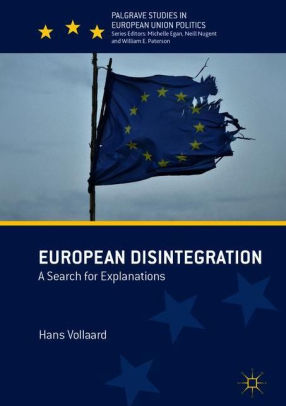

The European Union (EU) stands proudly as the longest and most advanced process of international/transnational collaboration among different independent countries in an effort to pool sovereignty to common policies for all members, the most important accomplishments being the EU’s single market, the European Single Currency (known as the Euro), and cross-border co-operation of the Schengen area. Moreover, it is the only international organization to ever receive the Nobel Peace Prize in 2012.”[1] Beginning as a small organization of six war-torn countries in 1957, the EU has enjoyed a period of ever-expanding competences (deepening) and members (widening); it currently stands after six decades of integration with twenty-eight members and more wanting to join.
However, throughout the last two decades, the EU has dealt with a seemingly never-ending string of crises, from the failure to ratify the EU constitutional treaty in France and the Netherlands, the Eurozone economic/debt crisis, which affected a number of peripheral Eurozone countries (Greece, Ireland, Portugal, and Cyprus, but also Spain and Italy),[2] and in 2016, when Europe was shocked by the UK’s decision to leave the EU after almost forty years of membership. More recently, a number of EU countries and the EU itself have been facing the Syrian refugee crisis. For some, these crises have put a serious dent in the EU’s popularity and prospects for longevity, while others have started to wonder whether the ending of the whole European integration process is near.
Against this backdrop, Hans Vollaard examines whether the EU is disintegrating or has already disintegrated, how far in advance one could tell if this was indeed happening, what this disintegration would look like, what kind of indicators of disintegration one should look for, and what factors can explain disintegration. Vollaard defines disintegration as not just the mere exit of an EU member or the EU’s total collapse, but also as “partial withdrawals” in the form of “withholding of resources, pulling out from (certain) decision-making process, and decreasing compliance with EU law, whether by member state governments, or businesses, individuals, and sub-state authorities.”[3] Vollard focuses on the political dimension of European disintegration understood as the allocation of EU values, such as “the EU legislative output, the scope of its policies, its competences, its institutions, the involvement and sense of belonging among its members (states and citizens), and the size of its territory.”[4] Thus, the book does not consider other aspects of disintegration, notably the economic dimension as discussed by the Optimal Currency Area theory regarding the Eurozone. Vollard’s main argument is that most of the mainstream EU theories either do not or cannot offer a comprehensive explanation or prediction of EU disintegration; rather alternative theories used for nation-state formation and representation of interests at the national level are better suited to explain or predict disintegration. Indeed, one of the objectives of the book is to expand on the framework suggested by Bartolini, which focuses on theories of state formation in European countries.[5] In addition, if one takes this argument to its logical end, one should not really expect an “Armageddon” style of disintegration in the form of a collapse of the EU, but rather partial withdrawals in policy areas or patchy implementation of some EU legislation.
The book is just over 250 pages and is neatly divided into ten chapters, discussing various theories of European integration and how they can explain or not explain EU disintegration. The book can be divided into two main parts. The first part consists thematically of chapters 2-5, presenting the mainstream theories of European integration, namely, neo-functionalism; realism, intergovernmentalism, and liberal intergovernmentalism; federalism; and comparative imperialism. In each case, Vollaard argues that these theories do not apply, and if they did apply,they would be inadequate to explain European disintegration. The second part consists of chapters 6-10, where the author argues in favor of Bartolini’s framework and aims to develop it further by introducing four propositions of European disintegration. In particular, Vollaard puts forward in the sixth chapter four propositions, which are as follows: Proposition 1 states that “the unattractiveness of alternatives and limited voice allowed European integration to take off;”[6] proposition 2 states that “the weak external consolidation of the EU and its predecessors has restrained its internal construction;”[7] the third proposition claims that the “external de-consolidation of the EU’s member states has weakened their internal construction.”[8] The fourth proposition is divided into two parts, with proposition 4a stating that “the stronger the EU-directed dissatisfaction, the lower the EU loyalty, the less (perceived) options to effective voice at the EU level, the less compensation for EU-directed dissatisfaction, the lower the perceived costs to leave the EU, and the better the perceived provision of values and goods by national or international alternatives to the EU, the more likely the full exist is.”[9] Proposition 4b states that “with high costs for leaving fully, and without high EU loyalty, effective voice in the EU, compensation for EU-directed dissatisfaction and attractive full exit options, EU-directed dissatisfaction induces partial exits within the EU and voice for the exit and non-entry of others.”[10] Each proposition is developed in a separate chapter from 7 to 10 chapters respectively in a theoretical rather than empirical fashion.
The book is definitely a welcome contribution to the field of study by discussing the key premises behind the process of European disintegration that any student of European integration should read and reflect about the state of the EU and its future. One could argue, however, that the book has some limitations. First, it adopts a rather generous definition of disintegration where opt-outs from EU policies or poor implementation of the EU acquis can be seen as signs of disintegration. This is arguably problematic given that, in some cases, poor implementation of EU policy may be down to low capability of member states and not resistance to integration.[11] Moreover, it is questionable whether opt-outs can be understood as examples of disintegration or examples of flexible integration, which actually prevents disintegration. The Danish opt-out from the Eurozone not only alleviated Danish fears of social dumping but also kept Denmark in the EU without any further resentment.
Secondly, readers may feel a bit disappointed that the book suggests propositions and not hypotheses. More importantly, some of the propositions seem either obvious or axiomatic, while others may be problematic to test empirically. For instance, proposition 1 does not take into account the historical context behind European integration, namely the aim to prevent another inter-European war by intertwining nation states with common policies overseen by an outside authority. Arguing that the lack of alternatives and limited voice was the main reason behind the take-off of European integration seems to be missing the “elephant in the room” of WWI and WWII, the European nationalism, war atrocities, and inter-European animosity of the previous century.[12] Propositions 2 and 3 seem a bit contradictory and somewhat problematic: the EU has a relatively strong external and internal construction without any problems (for instance the external common tariff of the customs union; the single market; the common voice in WTO) while at the same time traditional intergovernmentalists would argue that a stronger EU is not linked to a weaker nation state in Europe: on the contrary, the EU strengthens EU states by giving them economic, political and geo-strategic benefits that without the EU would not be available.[13]
Proposition 4, which really is two related but still separate propositions, is quite long and has a plethora of variables that are making difficult to empirically test their significance. For instance, proposition 4 seems unable to explain Brexit. Following figure 10.1, the full exit scenario is the result of a number of conditions that satisfy propositions 4a and 4b, but are not really applicable in the case of Brexit. In particular, when the UK expressed dissatisfaction with EU projects and policies, they were allowed to opt-out from undesirable policies like the Euro and Schengen. The UK also notoriously received a special rebate as compensation from the EU. Moreover, the UK has a considerable influence and voice in the EU being one of the most powerful and influential member state.[14] Britain will also suffer a very high cost from leaving the EU in the form of losing single market access and its voting rights/influence in the various EU institutions. In addition, it seems that there is no better alternative to EU membership. Despite all these conditions not being present that the author states are essential for a full exit, the UK voted and decided to fully leave the EU in 2016, a decision that it remains to be seen how if at all will be implemented. Thus, one wonders how useful these propositions are in explaining European disintegration.
Third, the book does not compare the EU with other integration efforts and claims that there have not been any large scale disintegration cases in Europe. One remains to wonder therefore why the book does not discuss at all the relatively promising alternative to the EU but ultimately failed effort of European integration: the European Free Trade Area (EFTA). The EFTA was set up as a rival to the EU, but its members gradually gave up the project and ended up members of the then EEC. It would have been quite a useful comparison to test integration vs disintegration with two real life examples and apply the book’s key arguments. For instance, the author gives great importance to satisfaction/dissatisfaction and loyalty. The EFTA, however, was hardly an issue of satisfaction or loyalty in terms of public opinion, parties and voting behaviour.
One final point that readers of the book should reflect upon is how seriously we should take the aforementioned crises as signs of EU disintegration. For instance, Brexit seems to have instigated a wave of pro-EU feeling among European nations,[15] while the UK seems to be in dire straits over managing the whole kerfuffle of leaving the EU. Similarly, the Eurozone remained intact and there is no crisis on the horizon for the Euro and most Eurozone members. Moreover, public opinion in Europe is increasingly becoming nationalistic but this is not so much about the EU per se but more about outside immigration/refugee crisis as seen in the case of Alternative for Deutschland in Germany.
In sum, the book is a timely addition to the field of European studies and tries to contribute to the discussion about the current state and future of the EU. It remains to be seen whether it provides more answers or questions but this is arguably one of the strongest aspects of the book’s appeal.
Reviewed by Sotirios Zartaloudis, University of Birmingham
European Disintegration: A Search for Explanations
By Hans Vollard
Publisher: Palgrave Macmillan
Hardcover / 265 pages / 2018
978-1-137-41464-9
References
Bartolini, S. (2005) Restructuring Europe: Centre formation, system building and political structuring between the nation state and the European Union, Oxford: Oxford University Press.
Europa (2012) ‘European Union receives Nobel Peace Prize 2012’, retrieved from: https://europa.eu/european-union/about-eu/history/2010-today/2012/eu-nobel_en
Hoffmann, S. (1966) Obstinate or obsolete?: the fate of the nation-state and the case of Western Europe, Daedalus, Journal of the American Academy of Arts and Sciences. 95. 1966, 3.
Mazower, M. (1999) Dark Continent: Europe’s Twentieth Century, Penguin.
Milward, A. (1992) TheEuropean Rescue of the Nation-State, 2nd ed., London: Routledge.
Moravcsik, A. (1998) The Choice for Europe: Social Purpose and State Power from Messina to Maastricht, Cornell University Press.
Papadimitriou, D. , Pegasiou, A. And Zartaloudis, S. (2019), European elites and the narrative of the Greek crisis: A discursive institutionalist analysis. European Journal of Political Research. doi:10.1111/1475-6765.12287
Vollaard, H. (2018) European
Disintegration: A search for explanations, Palgrave Macmillan.
[1] Europa (2012) ‘European Union receives Nobel Peace Prize 2012’, retrieved from: https://europa.eu/european-union/about-eu/history/2010-today/2012/eu-nobel_en.
[2] See Papadimitriou, D. , Pegasiou, A. And Zartaloudis, S. (2019), European elites and the narrative of the Greek crisis: A discursive institutionalist analysis. European Journal of Political Research. doi:10.1111/1475-6765.12287
[3] Vollaard, H. (2018) European Disintegration: A search for explanations, Palgrave Macmillan, page vi.
[4] Ibid,.5.
[5] Bartolini, S. (2005) Restructuring Europe: Centre formation, system building and political structuring between the nation state and the European Union, Oxford: Oxford University Press.
[6] Ibid, 139.
[7] Ibid.
[8] Ibid, 140.
[9] ibid, 141
[10] Ibid.
[11] Treib, O. (2014) “Implementing and complying with EU governance outputs”, Living Reviews in European Governance, Vol. 9, (2014), No. 1: http://www.livingreviews.org/lreg-2014-1.
[12] See inter alia, Mazower, M. (1999) Dark Continent: Europe’s Twentieth Century, Penguin, for an excellent historical analysis of how nationalism and socialism as anti-liberal ideologies almost destroyed Europe before during and after WWII.
[13] See: Milward (1992) and Hoffmann 1966.
[14] Cf. Moravscik 1998.
[15] See: http://www.pewglobal.org/2017/06/15/post-brexit-europeans-more-favorable-toward-eu/.
To read more book reviews click here.
Published on May 7, 2019.




